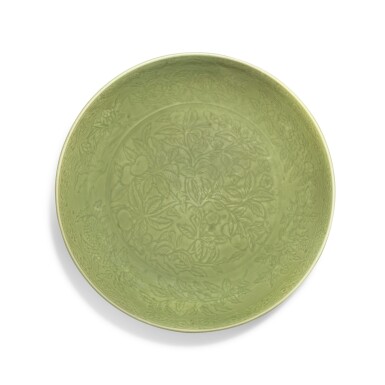Chinese Art
Chinese Art

An extremely rare 'Longquan' celadon-glazed 'crabapple' charger, Ming dynasty, Yongle period | 明永樂 龍泉窰青釉刻花大盤
Auction Closed
March 20, 05:40 PM GMT
Estimate
300,000 - 500,000 USD
Lot Details
Description
Diameter 22⅝ in., 57.5 cm
Collection of an Italian ambassador (b.1898).
Italian Private Collection.
來源:
意大利駐國大使 (1898年生) 收藏
意大利私人收藏
Highly impressive in its size, yet exquisite in its very rare decoration, this large Longquan dish is a true masterpiece of the early Ming period. With its superior craftsmanship and rare design, it stands out among other Longquan dishes known from this time and may have been specially commissioned by the court as an imperial gift to an important foreign potentate.
The finely rendered design of a fruiting and flowering crabapple tree delicately enclosed within a band of six floral sprays of chrysanthemum, lotus, rose, camellia, peony, is particularly rare and the fine quality of the glaze, carving and molding are characteristic of Longquan’s best early Ming productions. A reconstructed dish, larger in size – measuring 65cm diameter, was excavated at the Imperial Longquan kilns at Chuxhou, Zhejiang province, illustrated in Ye Yingting and Hua Yunong, Faxian. Da Ming Chuzhou Longquan guanyao [Discovery. Imperial ware of the great Ming dynasty from Longquan in Chuzhou], Hangzhou, 2005, pl. 6. Another example of the same size as the present lot, in the Topkapi Saray, Istanbul is illustrated in Regina Krahl, Chinese ceramics in the Topkapi Saray Museum, Istanbul, ed. John Ayers, London, 1986, vol. 1, pl. 242. A smaller example (35.9cm) with a composite scroll border, from the collection of Mrs. Nelson A. Rockefeller, was sold at Christie’s New York, 20th September 2005, lot 245.
The present dish belongs to a group of high-quality Longquan celadon wares produced in the late 14th to early 15th centuries that were characterized by their bold carved designs comparable with the blue and white porcelain contemporary to their time. During the early Ming dynasty, the Longquan kilns appear to have worked closely with the imperial porcelain kilns at Jingdezhen, thus making wares of similar form, decoration and quality. Compare an important blue and white dish approximately the same size (58.4cm) from the Griffing Collection, illustrated in Margaret Medley, The Chinese Potter. A Practical History of Chinese Ceramics, Oxford, 1976, pl. 145 (fig. 1).
Large-sized vessels, such as the present dish, commissioned by the court, were predominantly made to meet foreign taste. They played an important role in the emperor’s control of foreign trade and tributary relations. Upon his ascension to the throne in 1368, the Hongwu Emperor ordered that foreign diplomatic and trade contacts should be conducted through official government channels only, in the form of a tributary system. Further into his reign, these initial regulations became considerably less strict, as evidenced by the many Longquan pieces found outside China. The Longquan kilns, spreading over a large part of Zhejiang province and even further into the neighboring province of Fujian, were indeed conveniently located to reach the trade ports of Wenzhou and Quanzhou from where the merchandise could be shipped to foreign markets in the Far East, Southeast Asia and India, the Middle East and even as far as Africa. The Ottoman court in Istanbul was particularly keen on the rich, lustrous green glaze of celadon and the large size of the vessels suited Middle Eastern eating habits perfectly. Highly treasured, the best pieces were strictly reserved for the sultan and for special occasions. Valued and prized, they were offered as part of their princesses’ dowries or as rewards for outstanding services.
